Panicum
Panicum (panicgrass)[2] is a large genus of about 450 species of grasses native throughout the tropical regions of the world, with a few species extending into the northern temperate zone. They are often large, annual or perennial grasses, growing to 1–3 m tall.[3][4]
| Panicum | |
|---|---|
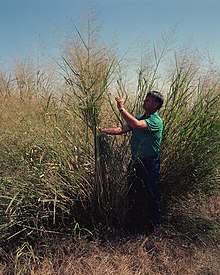 | |
| Panicum virgatum | |
| Scientific classification | |
| Kingdom: | Plantae |
| Clade: | Tracheophytes |
| Clade: | Angiosperms |
| Clade: | Monocots |
| Clade: | Commelinids |
| Order: | Poales |
| Family: | Poaceae |
| Subfamily: | Panicoideae |
| Supertribe: | Panicodae |
| Tribe: | Paniceae |
| Subtribe: | Panicinae |
| Genus: | Panicum L. |
| Synonyms[1] | |
| |
The flowers are produced in a well-developed panicle often up to 60 cm in length with numerous seeds, which are 1–6 mm long and 1–2 mm broad. The fruits are developed from a two-flowered spikelet. Only the upper floret of each spikelet is fertile; the lower floret is sterile or staminate. Both glumes are present and well developed.[5][6][7][8][9][10]
Australia has 29 native and 9 introduced species of Panicum.[11][12][13]
Well-known Panicum species include proso millet and switchgrass.
Selected species
- Panicum abscissum Swallen (endemic to Florida)
- Panicum amarum Elliott – bitter panicum (North America)
- Panicum anceps Michx. – beaked panicum (United States)
- Panicum antidotale Retz. – blue panicum (South Asia, Himalayas)
- Panicum capillare L. – witchgrass, tumbleweed[14] (North America)
- Panicum coloratum L. – kleingrass, coolah grass, Bambatsi panic (Africa)
- Panicum decompositum R.Br. – native millet (Australia)
- Panicum dichotomiflorum Michx. – fall panicgrass (North America)
- Panicum effusum R.Br. – hairy panic (Australia, New Guinea)
- Panicum fauriei Hitchc. – Faurie's panicgrass (endemic to Hawai'i)
- Panicum flexile (Gattinger) Scribn. – wiry panicgrass (eastern North America)
- Panicum hallii Vasey – Hall's panicgrass (North America)
- Panicum havardii Vasey – Havard's panicgrass (North America)
- Panicum hemitomon Schult. – maidencane (Americas)
- Panicum hillmanii Chase – Hillmann's panicgrass (North America)
- Panicum hirticaule J.Presl – Mexican panicgrass (Americas)
- Panicum lycopodioides Bory ex Nees – false club-moss panic grass (Réunion)
- Panicum maximum Jacq. – Guinea grass, buffalo grass (Africa, Palestine, Yemen)
- Panicum miliaceum L. – proso millet, common millet (domesticated)
- Panicum niihauense H.St.John – lau 'ehu (endemic to Hawai'i)
- Panicum obtusum Kunth – vine mesquite grass (North America) (possible synonym of Hopia obtusa)
- Panicum pygmaeum R.Br. – Australian native dwarf panicum, rainforest panicum
- Panicum repens L. – torpedo grass (widely introduced)
- Panicum rigidum Balf.f. (endemic to Socotra)
- Panicum simile Domin – two colour panic (Australia)
- Panicum socotranum Cope (endemic to Socotra)
- Panicum sumatrense Roth – little millet (Asia)
- Panicum turgidum Forssk. – afezu (Africa, Asia)
- Panicum urvilleanum Kunth – desert panicgrass (North America)
- Panicum virgatum L. – switchgrass (North America)
Formerly classified in this genus, according to The Plant List:
- Acostia gracilis, formerly named Panicum acostia R.D.Webster
- Echinochloa colona – jungle rice, formerly named Panicum colonum L.
- Echinochloa crus-galli – barnyard grass, formerly named Panicum crus-galli L.
- Urochloa panicoides – annual signal grass, formerly named Panicum helopus Trin.
Gallery
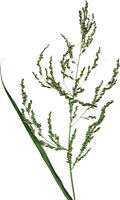

 Panicum maximum
Panicum maximum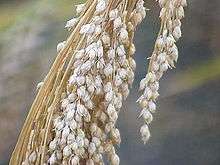
- Panicum phragmitoides

 Panicum torridum
Panicum torridum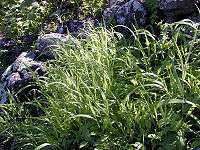 Panicum xerophyllum
Panicum xerophyllum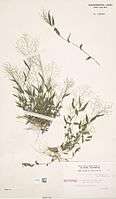 Panicum trichoides, isotype herbarium sheet
Panicum trichoides, isotype herbarium sheet
References
- Kew World Checklist of Selected Plant Families
- "Panicum". Natural Resources Conservation Service PLANTS Database. USDA. Retrieved 15 May 2015.
- Freckmann, R. W. & M. G. Lelong. 2002. Nomenclatural changes and innovations in Panicum and Dichanthelium (Poaceae: Paniceae). Sida 20(1): 161–174
- Valdes, B. & H. Scholz. 2006. The Euro+Med treatment of Gramineae - a generic synopsis and some new names. Willdenowia 36(2): 657–669
- Flora of China Vol. 22 Page 504 黍属 shu shu Panicum Linnaeus, Sp. Pl. 1: 55. 1753.
- Flora of Pakistan
- Altervista Flora Italiana, genere Panicum includes photos and distribution maps of several species
- Biota of North America Program 2013 county distribution maps
- Valdés-Reyna, J., F. O. Zuloaga, O. Morrone & L. Aragón Melchor. 2009. El género Panicum (Poaceae: Panicoideae) en el noreste de México. Boletín de la Sociedad Botánica de México 84: 59–82.
- Morrone, O., A. M. Antón & F. O. Zuloaga. 1995. Axonopus. Flora Fanerogámica Argentina. 19(1): 11–16
- Grasses of the Tweed Valley of NSW: An introductory field guide to locally common grasses: native and introduced, Compiled by Penny Watsford, Nullum Publications, 2004 ISBN 0-9756823-0-X)
- Ausgrass2, Grasses of Australia
- "Atlas of Living Australia". Archived from the original on 2016-05-27. Retrieved 2015-02-02.
-
- Britton, Nathaniel; Addison Brown (1896). An illustrated flora of the northern United States, Canada and the British Possessions From Newfoundland to the Parallel of the Southern Boundary of Virginia, and from the Atlantic Ocean Westward to the 102d Meridian. Volume I, Ophioglossaceae to Aizoaceae. Charles Scribner's Sons. pp. 612. page 123